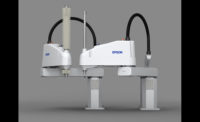If six-axis robots are virtually synonymous with automotive body shops, then SCARA robots are the kings of small-parts assembly applications. With their high speed, high precision and small footprint, SCARAs are ideal for automated assembly applications involving parts weighing less than 5 kilograms.
SCARAs have four axes of motion. The first two are radial joints in the horizontal plane. These allow the arm to swivel about its base and fold in on itself like a folding screen. The third, or Z, axis produces vertical motion, while the fourth, or Θ, axis produces rotational motion around the Z axis. In some cases, there can also be a bend at the end of the Z axis.
A SCARA’s work envelope is cylindrical. Models are available with a horizontal reach ranging from 250 to 1,200 millimeters, and a vertical reach ranging from 100 to 800 millimeters. Payload capacities vary from 2.5 to 50 kilograms.
Speed is a major advantage of SCARAs. The “cycle time” for any small robot is often reported as the time needed to move 1 inch up, 12 inches across, 1 inch down, and back again. Some SCARAs can complete this standard move in less than 0.4 second with a repeatability of ±0.008 millimeter. A six-axis robot would be unable to move that fast, simply because it has more motors to coordinate.
Compared with Cartesian robots, SCARAs require less table or floor space, but more headroom. A SCARA’s central axis is typically mounted to the floor or table, but the robot can also be mounted to the wall or ceiling. Mounting a robot over a conveyor, instead of next to it, can save a considerable amount space.
SCARAs excel in applications in which they pick something up with a straight vertical motion, transfer it horizontally, and place it back down with a straight vertical motion, without tilting the part. Many assemblers use SCARAs to pick parts off a conveyor and load them into pallets or packaging. With machine vision, SCARAs can scan randomly placed parts and identify those in the correct orientation or those with defects, even as the parts are moving on a conveyor.
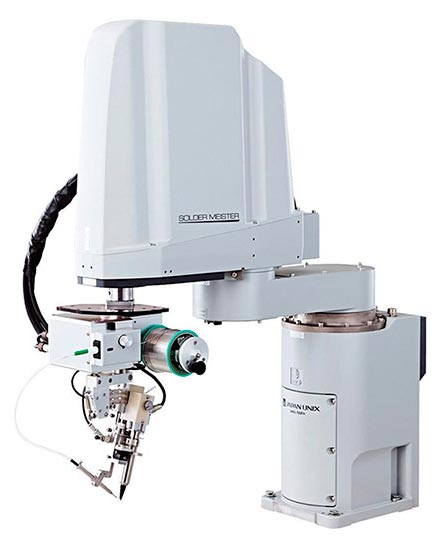
SCARAs are great for vertically oriented assembly processes, such as soldering. Photo courtesy Japan Unix
SCARAs are also good at vertically oriented processes, such as screwdriving, soldering and dispensing. In the latter application, for example, a SCARA can easily move a dispense head up and down slopes, but it can’t turn the tool 90 degrees and dispense adhesive along the side of something.
When specifying SCARAs, engineers should first determine the robot’s payload, which includes the weight of the gripper as well as the parts it will carry. Next, engineers should establish how far from its central axis the robot will need to carry the load, because that affects how much the robot can carry. The farther off center a robot must reach, the less payload it can carry. Even if the total payload is only 5 kilograms, engineers may need a robot with a 10-kilogram capacity if the arm has to travel far.
Other important specifications are cycle time, repeatability, work envelope, control system and network connectivity. The work environment is also an issue. SCARAs can be configured for static-safe operation, Class 10 clean rooms, wash-down environments, and humid, dusty environments.
Speed and Precision
The latest SCARA models give engineers a wide range of options for speed, precision, payload, reach, size and economy.
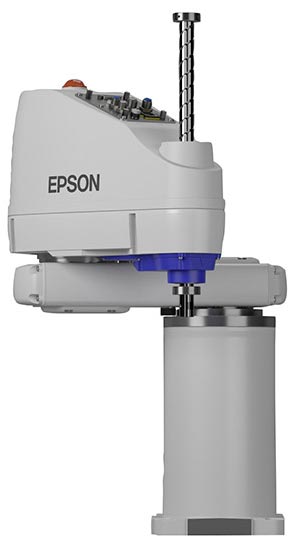
The new GX4 and GX8 SCARAs from Epson Robots are equipped with the company’s Gyroplus technology to provide fast speeds, smooth motion control, and high payload capabilities. Photo courtesy Epson Robots
For the ultimate in speed and precision, there are the new GX4 and GX8 SCARAs from Epson Robots. These machines are equipped with Epson’s patented Gyroplus technology to provide fast speeds, smooth motion control, and high payload capabilities. The robots are available in multiple arm configurations, with a maximum reach of 650 millimeters. They can handle a maximum payload of 8 kilograms. The robots have a slim design for easily integration into clean room and static-safe environments.
Epson’s RC+ software works seamlessly with the GX Series robots. With battery-free encoders and a built-in Ethernet cable, the GX Series provide a low total cost of ownership.
Gyroplus technology provides real-time velocity feedback directly at the end of the robot arm. This feedback is incorporated into the servo control loop, allowing the robot to achieve high precision and reducing vibration and settling time.
Traditional robot controls use angular velocity feedback located on the robot’s motor. But the true angular velocity at the end of the robot arm often differs from the motor’s angular velocity due to mechanical tolerances, friction, and the influence of peripherals, such as grippers and wiring. Previously, the most effective ways to reduce vibration were to increase rigidity by using a larger robot or to reduce acceleration and deceleration time. But these solutions mean increasing the robot’s footprint and cost or reducing cycle time and throughput.
Gyroplus technology addresses these problems by mounting an angular velocity sensor at the end of the robot arm. Now, the robot controller receives information about the behavior at the end of the arm and can deliver motion commands to address the exact movement and position of the robot arm, rather than an estimate based on the motor’s velocity. This means more precise positioning control and significant vibration reduction.
Economy and Simplicity
The T3-B and T6-B all-in-one SCARA robots offer high-quality and high-performance at an exceptional value to simplify both complex and simple automation applications, such as packaging, pick and place, dispensing, and inspection. These robots include the same intuitive software, features and reliability found in Epson’s high-end robots, while keeping total cost of ownership low.
The robots have a space-saving design that includes a built-in controller housed in the robot’s base with power for end-of-arm tooling. The T3-B and T6-B are compatible with Epson’s suite of integrated options, including vision guidance, IntelliFlex parts feeding, teach pendants, and fieldbus master and slave interface boards. Additional updates include an improved form factor design and updated motion control for smoother, faster cycle times.
Designed for ease of use, the T3-B and T6-B come equipped with Epson RC+ and no-code Epson RC+ Express industrial automation development software. Ideal for novice and advanced users, Epson RC+ is an easy-to-learn programming language that offers a powerful set of tools for automation. An intuitive, visual-based teaching environment, Epson RC+ Express is designed for users with little-to-no programming experience to easily and efficiently develop simple, powerful robotic programs.
The robots run on standard 110- and 220-volt power; no special panel or plug is required. No battery is required for the robot’s encoder, which minimizes downtime and reduces overall cost of ownership.
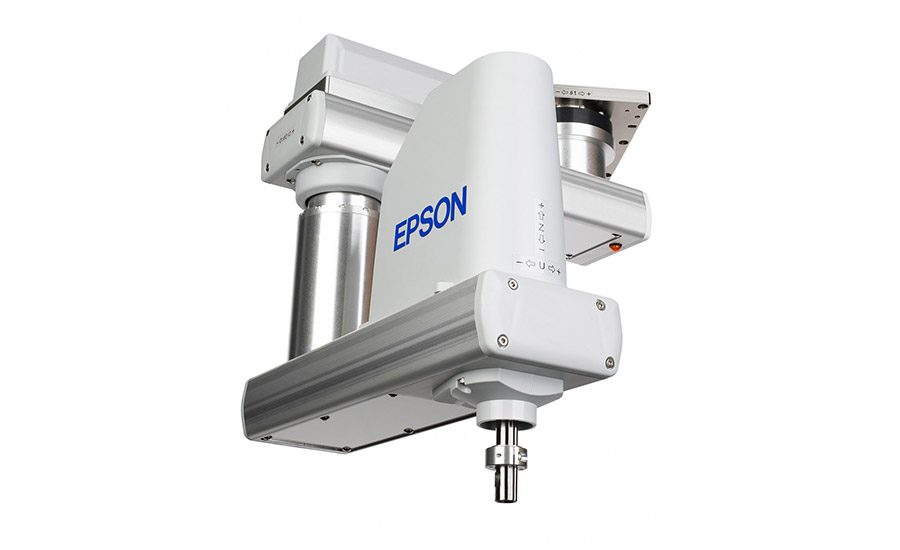
The RS series SCARA mounts to the ceiling and has the unique ability to move the second axis underneath the first axis, which allows it to move throughout the entire cylindrical workspace. Photo courtesy Epson Robots
Small Footprints
SCARA robots are said to have a cylindrical work envelope, but that’s not entirely true. It’s actually shaped more like a heart or a U, because of the robot’s base and because the robot can’t reach all the way behind its back. Epson’s RS series SCARAs solve that problem. The robots mount to the ceiling and have the unique ability to move the second axis underneath the first axis, which allows them to move throughout the entire cylindrical workspace. The unique arm structure of these robots covers the entire workspace underneath the arm, so there is no dead space in the center of the work envelope. They boast a positional repeatability of 0.01 millimeter and a cycle time of .339 second.
Two models are available. The RS3 can carry a 3-kilogram payload and a has 350-millimeter reach. The RS4 can carry a 4-kilogram payload and a has 550-millimeter reach. Both can be equipped for clean room and static-safe operation.
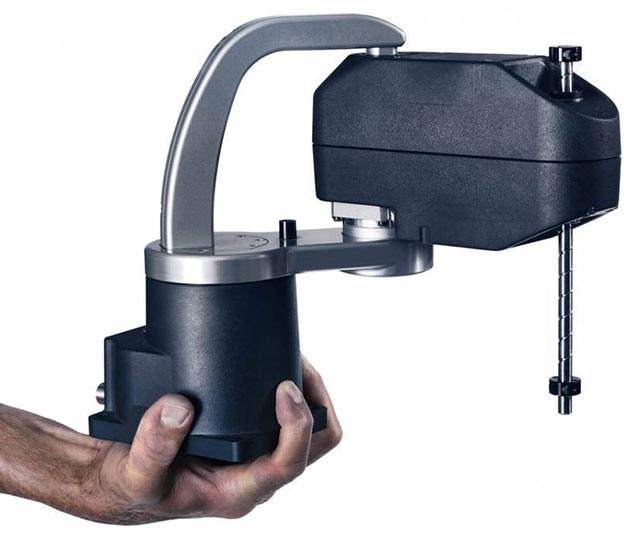
The micro-SCARA is the smallest SCARA robot on the market. Photo courtesy Mecademic Inc.
Mecademic Inc. has introduced the micro-SCARA robot. Building on the success and design principles of its Meca500 six-axis robotic arm, the micro-SCARA is the smallest SCARA robot on the market. Offering high precision and space optimization, it is ideal for small-component assembly applications in electronics, optics and medical device manufacturing.
“Our compact SCARA robot packs a big punch and continues our focus on achieving big automation leaps within the smallest possible footprint,” says Jonathan Coulombe, CEO of Mecademic. “This expansion of our product line was in direct response to customers asking us for a SCARA to complement our six-axis robotic arm. We are pleased to deliver on that promise with a product that is smaller and more than 50 percent lighter than the closest comparable SCARA.”
The robot has a reach of 225 millimeters, a Z stroke of 100 millimeters, and a rated payload capacity of 0.5 kilogram. It has a positional repeatability of 0.005 millimeter. It’s maximum speed in the X and Y axes is 2750 millimeters per second. It’s maximum speed in the Z axis is 900 millimeters per second. It has connection ports for EtherCat, Profinet, Ethernet/IP and TCP.
“We were one of Mecademic’s first participants in its early access program for this micro-SCARA robot,” says Shane Waskey, president of Mechatronic Solutions, an automation distributor in Maple Grove, MN. “We believe its compact size and high precision fills a gap in the automation market for applications and industries that are challenged by small parts and complex processes. With the trend towards miniaturization across many industries, we see strong demand for this robot.”
Dual-Arm Collaborative SCARA
Kawasaki Robotics has introduced the duAro2, a dual-arm collaborative SCARA robot with an increased maximum payload capacity and vertical stroke. While the company’s inaugural duAro1 model specializes in horizontal motion, the duAro2 improves upon its capabilities, extending the range of its arms’ vertical stroke by 400 millimeters (from 150 to 550 millimeters) and increasing the maximum payload of its arms by 1 kilogram per arm (from 2 to 3 kilograms per arm).
The wrist assembly has been redesigned, enabling the robot’s arms to fold like a human’s. This linkage design increases the vertical stroke while keeping the overall range of motion compact, and allows the robot to be used for a variety of applications, such as packaging and rack loading. The new option to detach the duAro2’s arms from the controller further enhances the cobot’s installation versatility, making it adaptable to a variety of needs in manufacturing sites, such as installation on conveyors.
The duAro2 robot runs on Kawasaki’s new F61 controller, which features options for Bluetooth connectivity, encoder-supported conveyor synchronization, and integrated 2D vision. The previous controller required a separate computer dedicated to image processing to use the vision functionality. Now, the F61 can handle image processing alone using an optional camera and software.
This controller architecture also allows for more flexible installation options. The controller can be housed inside the duAro2’s slim, wheeled cabinet (integrated installation option) or on its own, connected to the robot through cables (separated installation option). In the separated option, the arms are detached, enabling the use of duAro robots in almost any layout.
With their two coaxial arms operated by one controller, duAro robots can fit into a one-person space. In addition providing independent arm operation, the single-axis configuration enables the robots to easily perform coordinated arm movements, much like a person.
Low-power motors, a soft body, speed, force and work zone monitoring, and a deceleration function enable duAro robots to safely collaborate with people in work operations. In the unlikely event of a collision, the collision detection function instantaneously stops the robot’s movement.
The lead-through teach function allows engineers to easily teach the robot tasks by hand guiding its arms. Teaching operations can also be conveyed via a tablet that can be connected to multiple robots.
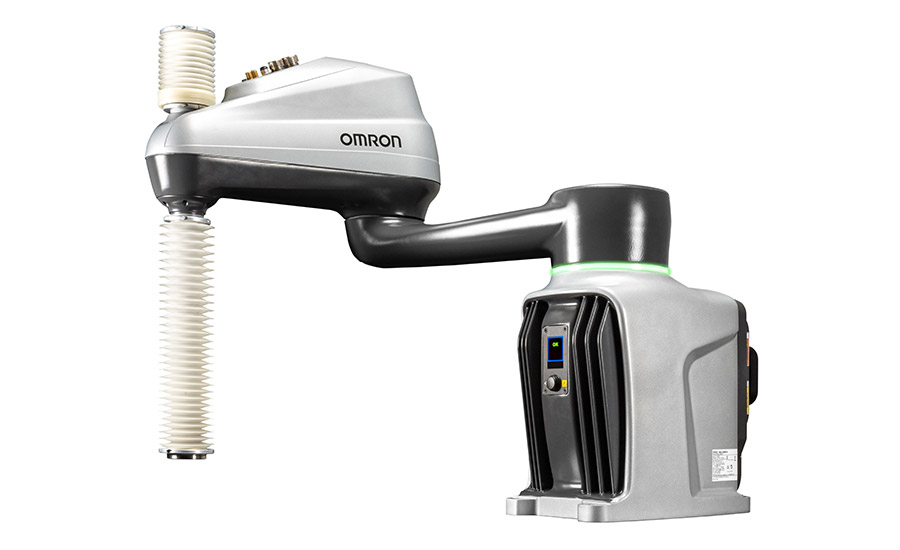
The new i4H SCARA robot has been optimized for static-dissipative and clean room applications. Photo courtesy Omron Automation
Static-Dissipative and Clean Room Model
The new i4H SCARA robot from Omron Automation has been optimized for static-dissipative and clean room applications.
The static-dissipative model has been designed to prevent the buildup of static electricity that can damage sensitive electronic components, while the clean room model can be used in environments that require very low particle emissions, such as pharmaceutical, medical or semiconductors industries.
The robot has a payload capacity of 15 kilograms and is available with a maximum reach of 650, 750 or 850 millimeters. The vertical stroke can be 210 or 410 millimeters. The robot can be mounted to a table or a wall. To save space, the controller is integrated into the robot and connects to shopfloor networks via EtherCAT or Ethernet.
ASSEMBLY ONLINE
For more information on SCARA robots, visit www.assemblymag.com to read these articles:
SCARA Robots Solder Circuit Assemblies
Robots Assemble Pressure Sensors
Robot Automates Assembly of Cricket Balls


